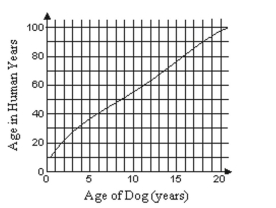Multiple Choice
Solve the polynomial equation. In order to obtain the first root, use synthetic division to test the possible rational
roots.
-The polynomial function
models the age in human years, , of a dog that is years old, where . Using the graph of this function shown below, what is the approximately equivalent dog age for a person who is 60 ?
A) 11 years
B) 9 years
C) years
D) years
Correct Answer:

Verified
Correct Answer:
Verified
Q150: The graph of a quadratic function
Q151: Find the slant asymptote, if any,
Q152: Graph the polynomial function.<br>- <span class="ql-formula"
Q153: Find a rational zero of the
Q154: Solve the polynomial equation. In order
Q156: Find the indicated intercept(s) of the
Q157: Graph the polynomial function.<br>- <span class="ql-formula"
Q158: Find the indicated intercept(s) of the
Q159: Graph the polynomial function.<br>- <span class="ql-formula"
Q160: Determine the constant of variation for